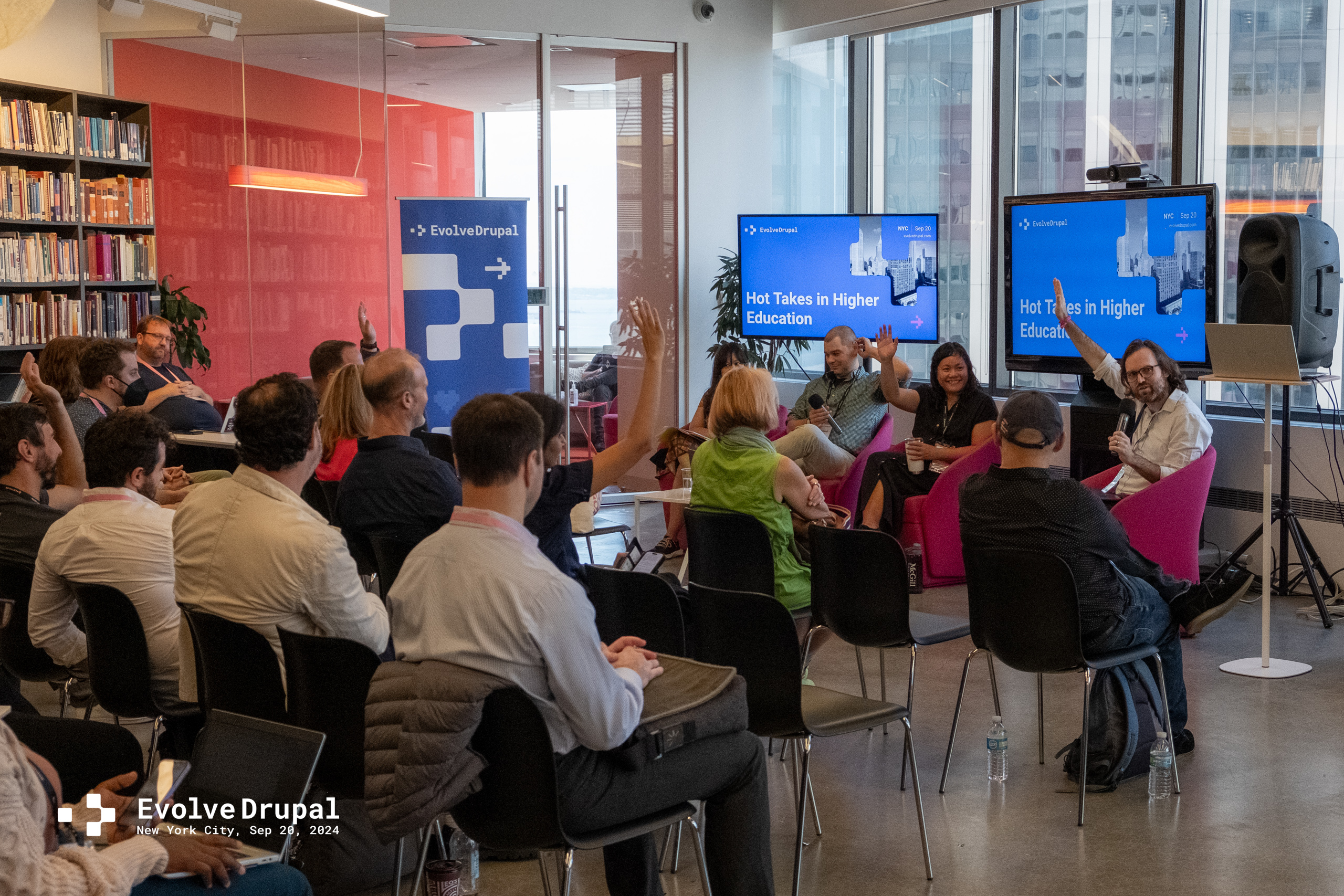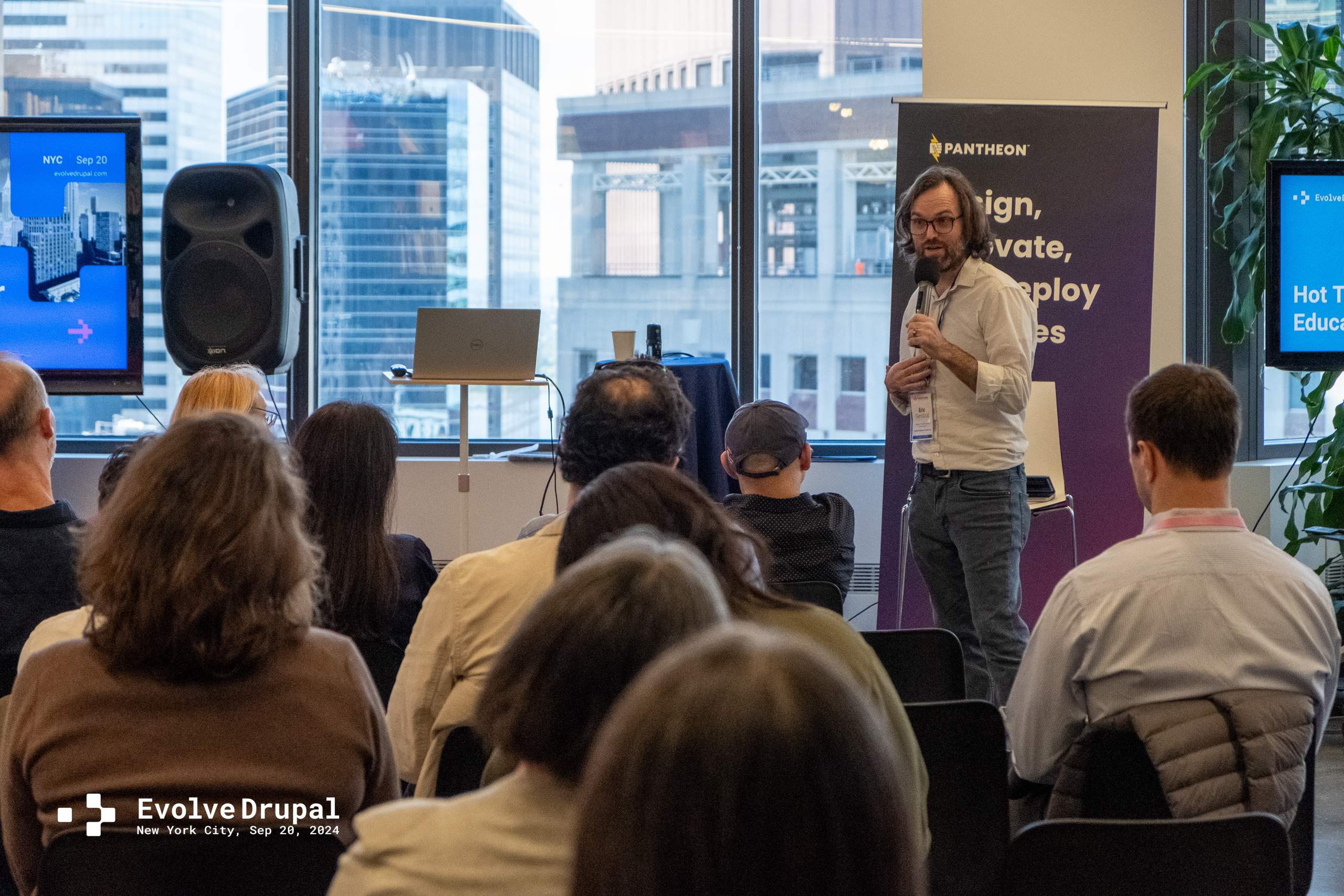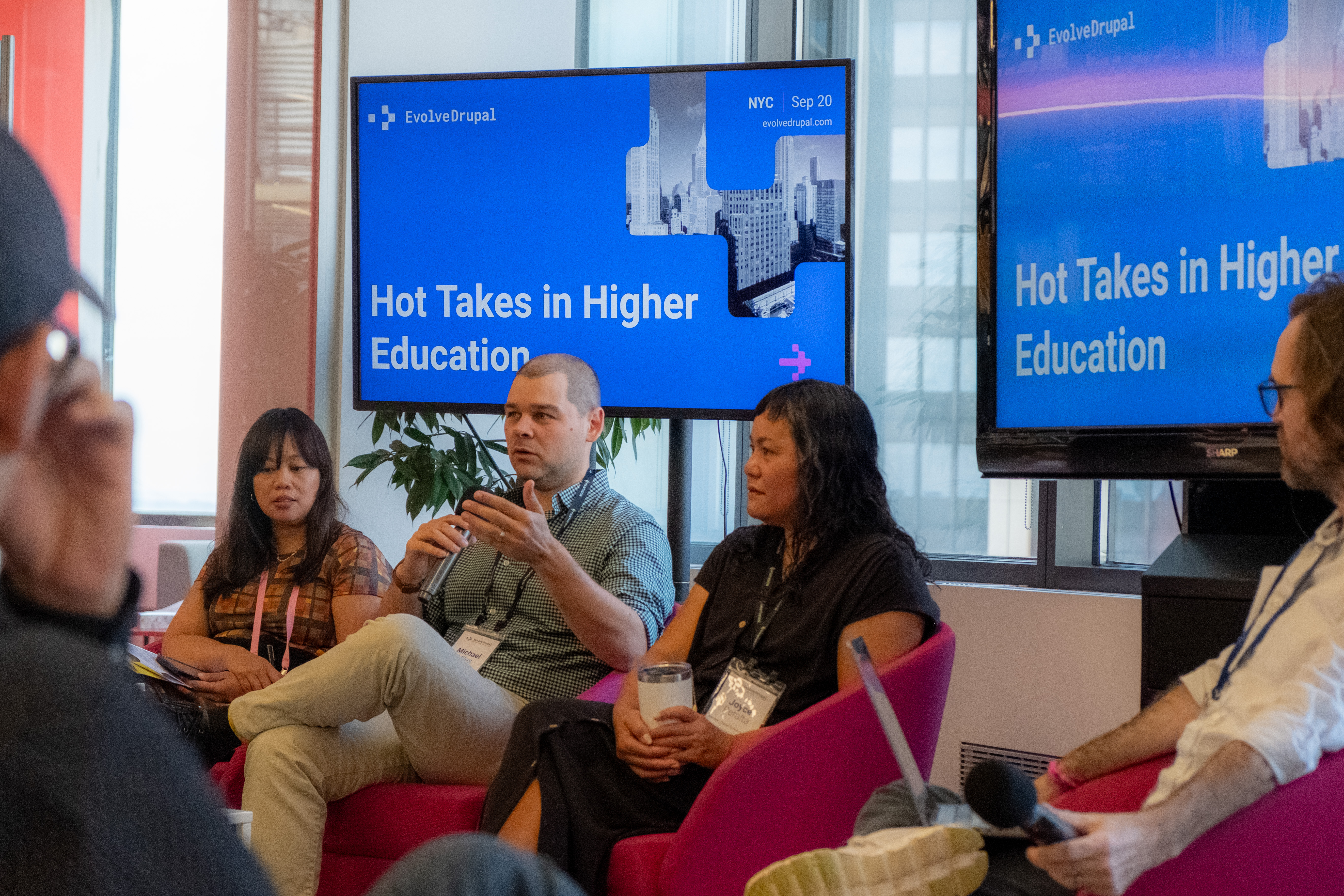Higher education is navigating unprecedented political, cultural, and economic challenges, both within and outside its institutions. As a result, many are turning to digital solutions to address some of these complex issues.
—Higher Ed Panel Moderator, Eric Sembrat, PhD
As part of our ongoing series where we share insights from the EvolveDrupal NYC summit, we’re excited to publish the Higher Ed Panel highlights. At EvolveDrupal NYC in September 2024, over 150 attendees came together to exchange ideas, share solutions, and inspire digital transformation. One of the highlights was a dedicated track on higher education strategy and digital communications, with experts from leading North American institutions.
This panel’s discussion covered the evolving landscape of higher education, with a focus on artificial intelligence (AI), open source software, and building community resilience. The special panel featured:
- Eric Sembrat, PhD, Director of Digital Learning Technologies at Georgia Tech, (moderator)
- Joyce Peralta, Manager, Digital Communications at McGill University,
- Michael Miles, Director of Web Development at the MIT Sloan School of Management,
- and Sofiya Cabalquinto, Chief Marketing & Communications Officer at the Rhode Island School of Design.
To hear it straight from the source, listen in to the full unedited version:
Artificial Intelligence: Hot Topic or Lukewarm Trend?
It wouldn’t be 2024 if the conversation didn’t begin with AI! In education, it has affected and is expected to further influence marketing, communications, and instructional approaches. Since generative AI tools are becoming more commonplace and diverse, the panel weighed in on successes and challenges in integrating AI into higher education.
At McGill, the initial surge of interest has passed. Lately, the discussions have been more structured on how exactly AI folds into the mature governance framework and methodology that was developed for handling compliance before the advent of AI. Just because AI is now a factor, doesn’t mean that the existing standards do not apply! McGill’s Digital Communications team is committed to ensuring content accessibility, minimizing environmental impact, and reviewing for accuracy. Collaboration and sharing are also key community values, which are key for helping the McGill ecosystem learn and adapt.
Sofiya Cabalquinto was able to speak to the AI processes at the Rhode Island School of Design, as well as at the Harvard Kennedy School of Business (HKS), her previous employer. The focus at HKS was on leveraging AI in digital communications to fulfill the school’s mission: improving public policy and leadership. An effective AI use case was amplifying the capacity of two full-time writers reporting on the findings of twelve world-class research centers. Their team automates mundane research tasks (e.g. alphabetization) and combines the knowledge translation capacity of AI with human oversight for social media posting.
At MIT Sloan, the bar is consistently high for implementing new technologies like AI. Michael’s team uses AI to make writing code more efficient. On the institutional level, their IT and faculty teams established universal standards for AI use and internal guidance, both available online. The real challenge is adapting these rules to different needs across the institution. A recent successful implementation involved a research group developing an AI chatbot to help people identify fake news and misinformation.
AI Best Practices in Higher Ed
As for promoting best practices in using AI, our panelists spoke to both internal and external strategies, as thankfully some of these institutions make their knowledge leadership public.
For Joyce Peralta, working with the McGill community of practice is key in formalizing best practices. It is a priority to arrive at structures that will work best for the users in the university ecosystem. While this process is in progress, the Digital Communications team created a note on the digital standards page to remind everyone that AI-generated content is no exception and needs to comply with all the same standards. The team is starting small and experimenting to see what works, before committing to AI tools fully. They are also integrating AI-related training into existing courses. Both efforts are meant to support, reassure and guide the community, where some are extremely enthusiastic about AI, while others are just as worried that their jobs might be at risk.
For MIT, AI has been used to help with ideation and content planning, but never – to generate final content that could potentially put the school’s reputation at risk because it represents the institution. They have established AI policies to always make sure there’s a human review, verifying the accuracy and appropriateness of what’s being published.
Open Source
The discussion then shifted to open source usage in higher education. McGill uses a centralized Drupal-powered platform to run over a thousand university sites. Their in-house development team works to simplify collaboration and customizes the platform to meet the digital communication teams’ needs, which would have been more difficult with an enterprise system and external developers. As a result, the McGill team creates a cohesive platform experience for users, which is a crucial aspect of their institutional goals.
Michael Miles, coming from a developer world and a prominent member of the Drupal community since 2009, spoke about MIT’s long history with open source. Their smaller team takes advantage of the larger Drupal community to reach for support and solutions. One of the key benefits of long relationships is the ability to get advice from a broad network of people, instead of relying on a single vendor.
As far as contributing back to the community, MIT developers participate in Drupal events, contribute code, and help with organizing community events like EvolveDrupal. Their team also gets involved in contribution days to continuously improve Drupal, benefitting every single actor in the community. Similarly, McGill University got the inspiration from the Drupal community to build a similar community of practice within their institution. “The open source platform has helped us create momentum for building a strong collaborative culture in web development.” (Joyce Peralta) Meanwhile, at Georgia Tech, institutional governance was historically in the way of embracing open source. Luckily, they have taken a step forward by streamlining the processes to allow the team to innovate and take advantage of Drupal infrastructures more fully.

Fostering Resilience in Higher Ed
After discussing challenges and ways that their institutions have coped with the advent of AI, they considered resilience in higher education: building sustainability and keeping communities engaged, despite an array of pressures in the world of politics, economics, and culture.
Sofiya Cabalquinto admitted that the past two years have been the hardest in her nearly 20-year career, and post-pandemic the situation is akin to a crisis in higher education amid funding cuts. However, the drive is strong to engage the public in addressing issues like democracy, voting, or understanding complex global conflicts. Communications experts in higher education have an important role to play! What has helped build resilience at RISD is proactive communication, whether it comes to program updates or educational opportunities.
At MIT, the focus has been on ensuring that communication gets out quickly and accurately, especially when dealing with crises. From a web development standpoint, this means building adaptable systems that can handle urgent updates. This allows the technology to support quick dissemination of information and reach those goals.
For McGill, understanding how their audience perceives all of the current issues is an ongoing process. By conducting user experience research, they gauge changing attitudes and adjust communications strategy accordingly. “It’s definitely something we’re considering more deeply as we navigate these challenging times.”
Rapid Fire Round: Q&A
“How can AI be used in programming and digital experiences?”
Michael brought up the work of the team at Yale University, who built an AI chatbot for their website to help students find things like dining options. The bot uses content from the website to generate answers, which makes it very interactive and helpful.
As for MIT, they use AI to speed up coding work and prompt the developers when they have to use new technologies or languages they are not as familiar with. “The idea is to let AI handle repetitive tasks, so we can focus on higher-level objectives.”
“How do you convince people apprehensive about AI to adopt it?”
Joyce: Start small! Showcase simple tasks that AI can assist with to let the people get comfortable. It’s about building familiarity and demonstrating how AI can make their jobs easier.
Michael: We regularly hold training sessions to inform people about AI capabilities and limitations. Keeping everyone educated and up-to-date is key.
“What are some risks of overly enthusiastic adoption of AI?”
Michael: There’s a risk of putting out inaccurate or misleading information, if people use AI without proper governance. That’s why we have strict policies on what AI can and cannot be used for.
Joyce: There are concerns about amplifying bias, especially for marginalized communities. We need to ensure that AI is used responsibly and inclusively.
Sofiya: At Harvard, we had an AI 'playground' where staff could experiment with AI tools in a controlled environment, which helped mitigate risks.
"We’ve seen a massive shift from on-premises to cloud hosting over the last 10 to 15 years. Are you considering rethinking the value proposition of cloud hosting and SaaS, or are you still fully committed to them?" —Evolving Web Co-Founder, Alex Dergachev
Michael: For a while, we had a multi-press site that used to be on-prem, and it was challenging. We had my team communicate with their team to get updates and changes, to keep it updated. With our SaaS product, it’s a lot easier and much more streamlined. We’re still all-in on SaaS, rather than hiring employees to focus on this one thing.
Eric: For GeorgiaTech, I appreciate our host because it’s free and easy to set up. I would love to transition to a cloud service provider that offers hosting with semi-automated updates and easier management of backups – where I can run Drush to clear caches or perform security updates on 25 to 30 sites. From experience, doing that manually is not a fun effort. I don’t know what institutions are doing it right, but I want to meet them!

“How do you approach accessibility when working with vendors?”
Michael: In our experience, we’ve been able to apply pressure to SaaS companies. We told them, “We want to keep using your product, but it has to be WCAG compliant; otherwise, we can’t use it.” That pressure helped them direct developers to focus on improving accessibility, benefiting everyone who uses the tool. I like the idea that we can collectively pressure companies to make these improvements – not just for our unit, but for everyone.
Joyce: We all need to be diligent about making sure that we identify accessibility as a priority for us. It’s not just about specific issues; it’s about ensuring that accessibility is a fundamental aspect of the product overall.
For more insights on designing for neurodivergent users, check out our blog post, Cognitive Accessibility: Designing Digital Experiences for Neurodiverse Users.
Finally, Hot Takes!
Eric: Stop using video backgrounds on university websites. They slow down load times, and nobody watches them! If anyone has a good use case, I want to know what it is.
Michael: My hot take is that the technology you use doesn’t really matter. Whether you're using Drupal or WordPress or Adobe – they're all essentially the same. In all my years working in the agency world, I had to find the best tool for the right client. What you care about is who can use it and how well it works for your university.
Joyce: I want to address that we often forget to make the resources we produce accessible. While we show people how to build accessible websites, we don't create accessible resources for instruction. I believe we need to adopt our own best practices regarding accessibility in the tools we provide for our community.
To be in on conversations like this one live, join us at the next EvolveDrupal Summit!
EvolveDrupal Toronto is on December 6, 2024.

